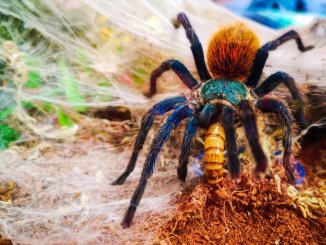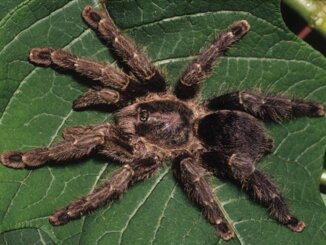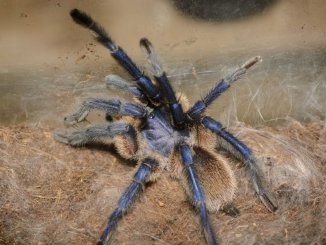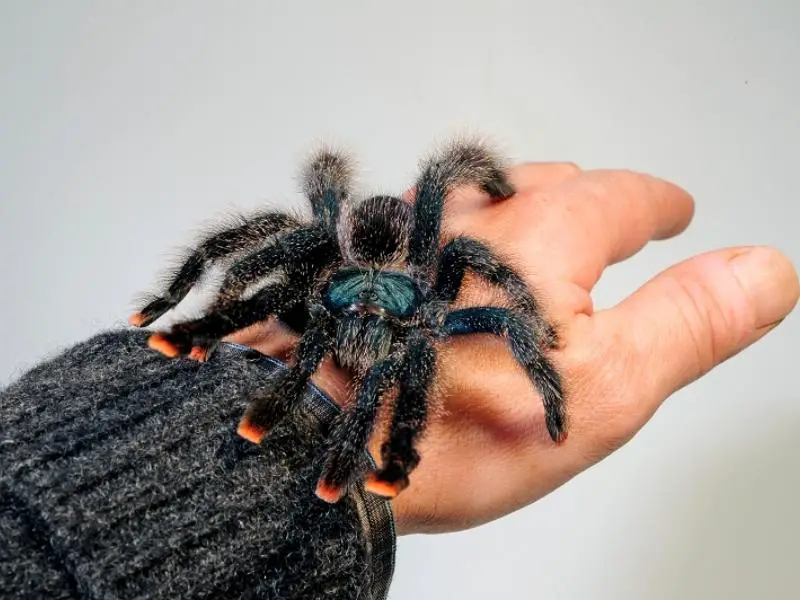
Avicularia metallica, or the metallic pinktoe tarantula, is an arboreal tarantula hailing from the shaded, humid forests of South and Central America.
Caring for Avicularia metallicas is moderately difficult. The tarantulas have simple care needs and docile personalities, but they’re sensitive to their environment and are more susceptible to health problems than other tarantulas.
Avicularia Metallica Overview
| Common name | Avicularia metallica, metallic pinktoe tarantula, South American pinktoe, Guyana pinktoe, common pinktoe |
| Scientific name | Avicularia metallica |
| Natural habitat | Natural habitat Tropical forests and jungles in South and Central America |
| Adult size | 3.5–5 inches |
| Average lifespan | 4–8 years |
| Diet | Carnivore |
| Housing | Minimum 10 gallons, 60–80°F, 65%–75% humidity |
| Experience | Intermediate |
Origin
Avicularia metallica originates in the shaded tropical forests and jungles of Central and South America including Costa Rica, Brazil, and the southern Caribbean. The spider’s habitat is warm and humid throughout the year.
In their natural environment, metallic pinktoe tarantulas don’t spend much time on the ground. The tarantulas are arboreal (tree-climbing) and live in trees, where they spin large webs to catch their food. They hunt during the night and subdue prey with their large size.
Appearance and Behavior
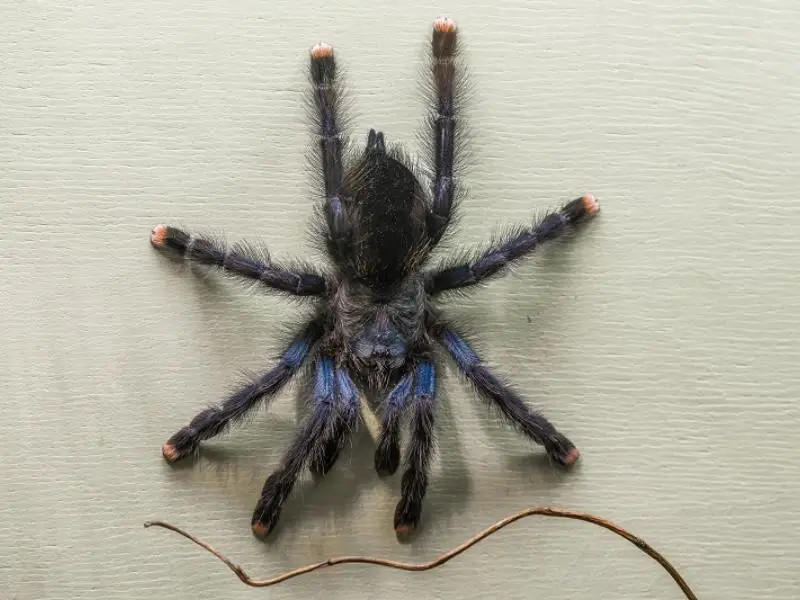
The Avicularia metallica has a fuzzy, furry body and light, cream or pink toe tips that resemble paws, giving it the common name “metallic pinktoe tarantula.” The soft pink hairs on the spider’s toes are used to climb surfaces, listen for danger, and feel the surroundings. Two hooked claws on each toe are used for climbing and web-walking.
This tarantula species has a large, thick body and eight legs. Baby metallic pinktoe tarantulas hatch with pink bodies and black toe tips — opposite colors to their parents. The spiders’ color changes as they age. Adult Avicularia metallicas have black, dark blue, or gray bodies with green- or purple-hued heads and legs.
All metallic pinktoe tarantulas have chelicerae and pedipalps — two pairs of specially modified appendages — near their mouths. The chelicerae contain the spider’s venom, and the pedipalps are used by the spider to sense objects, make webs, and capture prey.
Metallic pinktoe tarantulas are closely related to purpletoe tarantulas (Avicularia purpurea) and versicolor pinktoe tarantulas (Caribena versicolor). Purpletoe tarantulas are larger and have a different coloration than the common pinktoe. Versicolor pinktoes are similar in appearance to common metallic pinktoes but can only be found in Martinique in the Caribbean Sea.
Size and Lifespan
The average length of an Avicularia metallica is 3.5–5 inches. Females are larger and heavier than males and grow to 4.5–5 inches long, while males usually stop growing when they reach 3.5 inches long.
Baby metallic pinktoe tarantulas are sold when they’re 1–2 inches long. Young spiders molt frequently and grow quickly into their adult size. The exact size of a pinktoe tarantula is determined by the spider’s diet and the enclosure temperature (frequent feeding and warm temperatures increase the speed of growth).
The lifespan of a metallic pinktoe tarantula is determined by the spider’s gender and the quality of care it receives. Female Avicularia metallicas live for 6–10 years, while males live for 3–6 years, even with proper care. A poor diet and a dirty or suboptimal enclosure are known to shorten the spider’s lifespan.
Temperament
Avicularia metallica is a shy, skittish tarantula that hides in webs and under plants throughout the day. In captivity, this spider species makes its own hiding spots by wrapping its web around various plants near the upper corner of the enclosure.
Metallic pinktoe tarantulas are usually docile, but they may display defensive behaviors if startled. A spider that senses danger may release irritating urticating hairs and raise its front legs to show its fangs. Metallic pinktoes are mildly venomous, with a bite that feels similar to a bee sting, and are only known to bite as a last resort.
Housing Avicularia Metallicas
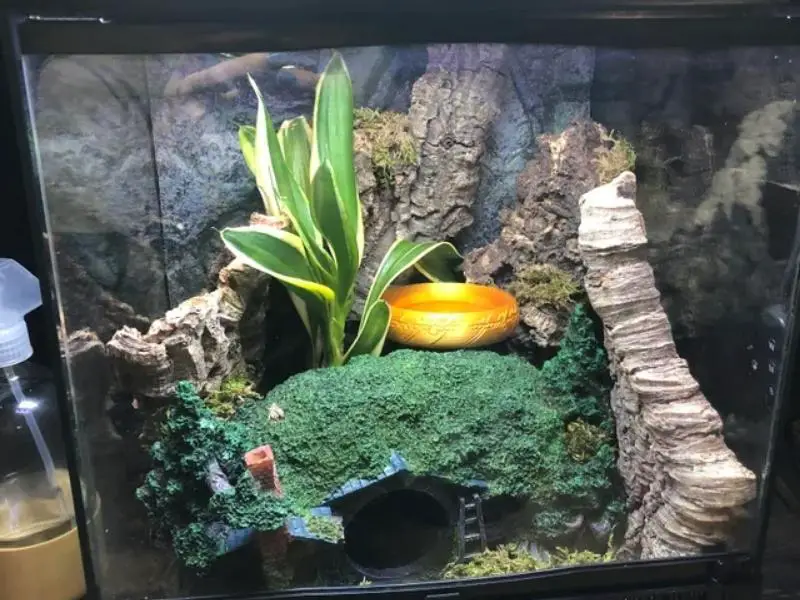
Avicularia metallica’s natural habitat is tropical, humid forests in warm regions in South and Central America. Provide a similar environment in the spider’s enclosure to ensure the spider is comfortable in its surroundings.
Keep metallic pinktoe tarantulas in a tall glass terrarium.
Enclosure size
The ideal enclosure size for Avicularia metallica is 10 to 20 gallons. The spider is arboreal and spends most of its time climbing, so the enclosure should be at least 18 inches tall to accommodate tall plants and climbing branches. The tank’s width and depth should both be at least 12 inches.
Lighting
Avicularia metallicas don’t require special lighting, such as UVB light. Make sure the enclosure is placed in a room that receives at least eight hours of sunlight so that the spider can differentiate between day and night.
Avoid placing the enclosure in direct sunlight, which may cause overheating. To encourage healthy growth in a tank that contains live plants, install a standard LED lamp above the top of the enclosure and set the lighting on a 10-hour day/night cycle.
Temperature
The metallic pinktoe tarantula is a hardy spider that tolerates a temperature range of 60–85°F in the enclosure. The optimal temperature range for the spider is 72–82°F.
Create a horizontal temperature gradient in the enclosure to allow the spider to move between cooler and warmer parts. Place a heat mat on the bottom of the enclosure, covering one-third of the space.
Monitor temperatures in the enclosure with a thermometer and adjust the heat level with a thermostat.
Substrate and Decoration
Avicularia metallica spends most of its time above the ground and doesn’t burrow like other tarantulas, so substrate choice for this spider isn’t important. Choose a soft, non-abrasive, easy-clean substrate that maintains humidity levels without growing mold, such as peat moss, coconut coir, and orchid potting mix.
Metallic pinktoe tarantulas are used to living in a densely vegetated environment, with the shaded canopy of trees blocking out direct sunlight. Provide a similar habitat in the wild with a combination of live and artificial plants, which provide places to hide and encourage natural behaviors like web building.
Good decorations for an Avicularia metallica enclosure are sticks, cardboard tubes, cork bark, and branches. Spiders of this species commonly create a silk-lined nest or tunnel at the highest point in the enclosure, so make sure the spider has access to this area.
Cleaning
Spot-clean the metallic pinktoe tarantula’s enclosure once a day. Replace dirty substrate and clean out the spider’s water bowl, replenishing the water with a fresh batch.
Deep-clean the enclosure at least once a month. Place the tarantula in a separate enclosure and remove all decorations. Wipe down the decorations and plant leaves with a damp cloth and use a wet sponge to clean the enclosure walls and floor. Dry the enclosure, then add a fresh layer of substrate and return the clean decorations.
Only use water to clean your tarantula’s enclosure. For tough stains, use equal parts water and white vinegar. Don’t use chemical cleaning products, soap, or washing liquid, which could make the spider sick.
Avicularia Metallica Care
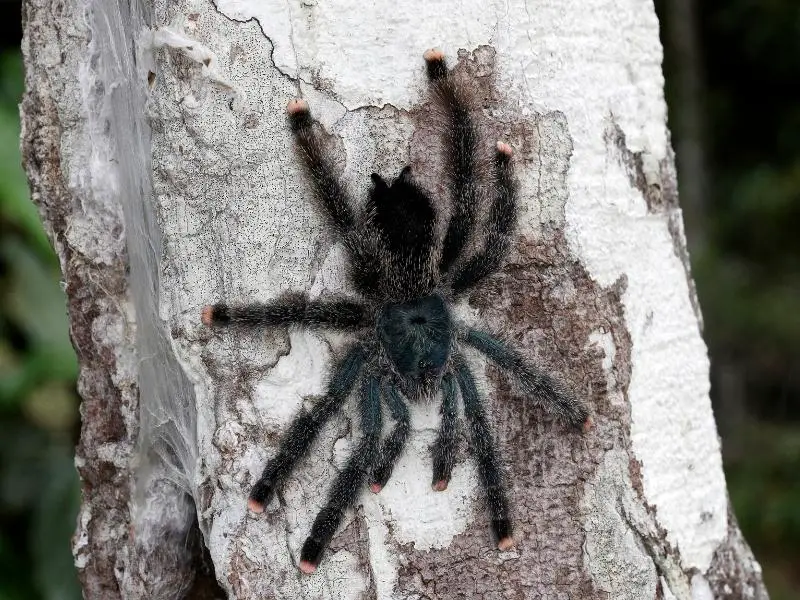
Looking after Avicularia metallica in captivity is moderately challenging. The spiders are healthy eaters, but they’re prone to getting sick if they’re housed in unclean or suboptimal conditions.
Food and Water
In the wild, the metallic pinktoe tarantula eats a carnivorous diet of crickets, beetles, and locusts. This opportunistic predator also hunts and catches lizards, amphibians, and small mammals. Pinktoe tarantulas hide in the shadows and ambush their prey.
Mimic the spider’s varied protein-rich diet in captivity by providing dubia roaches, mealworms, and crickets. Make sure the insects are gut-loaded to provide additional nutrition. Add the insects live to the enclosure to encourage the spider to display its natural hunting behaviors. Live pinkie mice can also be occasionally added to the enclosure.
Feed adult Avicularia metallica three to four large insects every seven to ten days. Juvenile spiders need more frequent feeding to support their rapid growth phase. Provide juveniles with six to eight small insects every two to three days.
Pinktoes hunt overnight in the wild, so schedule your tarantula’s feeding sessions for the evening. Drop the live prey directly into the enclosure and allow your spider to hunt overnight. The next morning, remove any leftover uneaten prey to keep the enclosure clean.
If your spider stops eating for a few weeks, it’s a sign that they’re preparing to molt.
Handling
Avicularia metallica is skittish and jumpy, so the spider isn’t a good choice for people who want a pet that they can handle.
To avoid stressing your spider, only handle the spider when absolutely necessary, such as to perform a health check or to move the spider to a new enclosure. Children shouldn’t handle a pinktoe tarantula.
Don’t handle your spider for at least a week after it has molted, while its new exoskeleton hardens.
Molting
Avicularia metallica grows by shedding its tough exoskeleton to form a larger, newer protective layer. The frequency of molting depends on the age of the spider — juveniles grow at a faster rate and molt more frequently than adults.
When a tarantula molts, it stops eating for up to two weeks and appears lethargic and sluggish. The spider flips over and curls its legs in when the old exoskeleton begins to split. The tarantula should molt within three hours. Once the spider has abandoned its old exoskeleton, the shell can be removed from the enclosure.
Common Health Issues
Avicularia metallicas are prone to a number of common health issues experienced by tarantulas in captivity. Most of these conditions can be avoided by maintaining clean, optimal enclosure conditions.
Dehydration
Dehydration is a common problem in spiders housed in incorrect conditions. A wrinkled appearance and a shrunken abdomen are two signs of dehydration in pinktoe tarantulas. A lack of water, a lack of food, and low humidity levels are all causes of dehydration. To treat this condition, offer the spider a shallow dish of water and reduce ventilation in the enclosure to maintain optimal humidity.
Molting Problems
Some people confuse molting with signs of a sick spider. A healthy pinktoe tarantula should molt completely within three days. Low humidity levels (less than 60%) in the enclosure can cause the spider to get stuck in its molt, resulting in immobility and even death. Prevent molting problems by maintaining a humidity of around 75% and misting the enclosure once or twice a day during molting.
Exoskeletal Injuries
Metallic pinktoe tarantulas are a climbing spider species, which means they’re at a higher risk of falls and exoskeletal damage than other tarantulas. Reduce the risk of falls by removing hard, sharp objects from the enclosure and adding springy, soft vegetation that will safely break the tarantula’s fall. Seek immediate veterinary care for injuries due to falls. Tarantulas have delicate bodies and some injuries may be fatal.
Breeding
In the wild, Avicularia metallicas lay between 50 to 200 eggs that hatch in six to eight weeks. The spiders reach sexual maturity when they’re about 2.5 years old. Males die within a few months of breeding.
The pinktoe tarantula is known to readily breed in captivity, but little information is available on the exact steps to achieve breeding success.
Males have hooks on their first pair of legs, which they use to grapple with females during mating. Once a male has produced a sperm web, carefully introduce the spider to the female’s enclosure.
The female should have recently completed a molt to be ready for breeding. After mating has occurred, provide the female with a high-protein diet to prepare her to lay her eggs.
Spiderlings can be fed a diet of crickets and other small insects until they’re large enough to be moved into separate enclosures or sold.
Choosing and Buying Avicularia Metallica
The average cost of an adult Avicularia metallica is $20 to $40. Females are typically more expensive than males because they live longer and look more attractive than males. Spiderlings are cheaper than adults, costing $5 to $10 on average, because of the care involved in raising a tarantula from a young, fragile age.
Metallic pinktoe tarantulas are available for sale at specialty exotic pet shops and online. Breeders sell these spiders at reptile expos. Avicularia metallicas aren’t usually available at standard pet shops.
When shopping for a pinktoe tarantula, look for captive-bred tarantulas, which are tamer and healthier than wild-caught tarantulas, which are more skittish and at a high risk of disease and parasites. Avoid spiders that exhibit signs of poor health, including a shrunken abdomen, mites around the eyes and mouth, and open wounds. Ask the breeder to see the spider eating and molting before you buy it.

